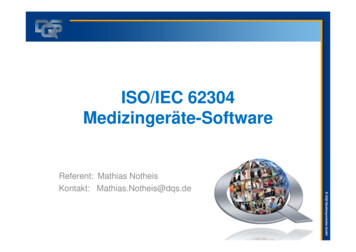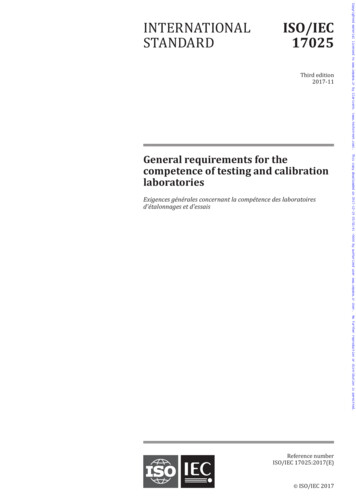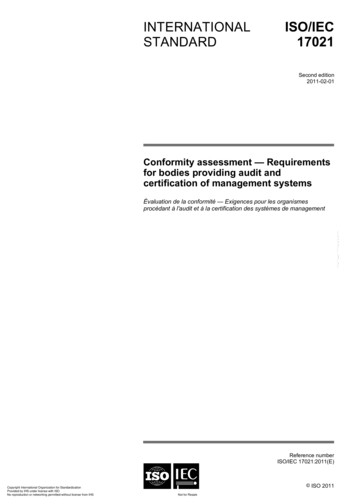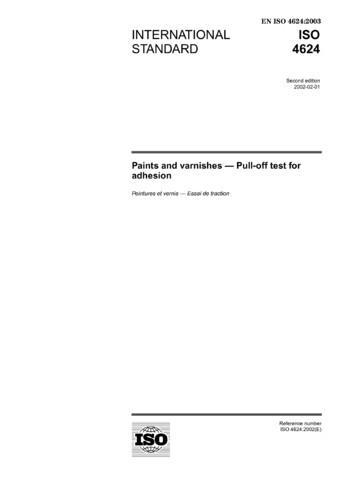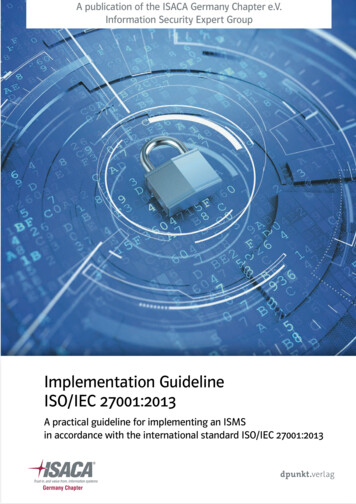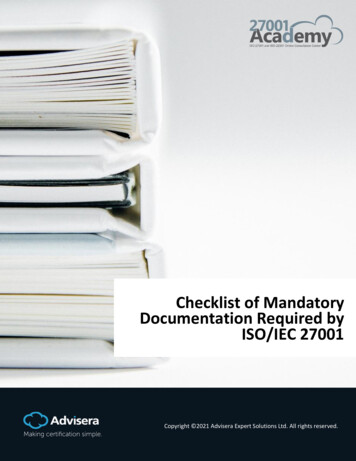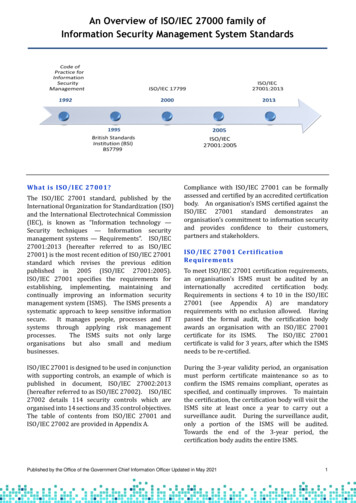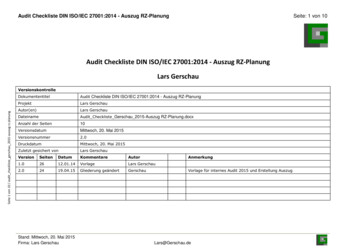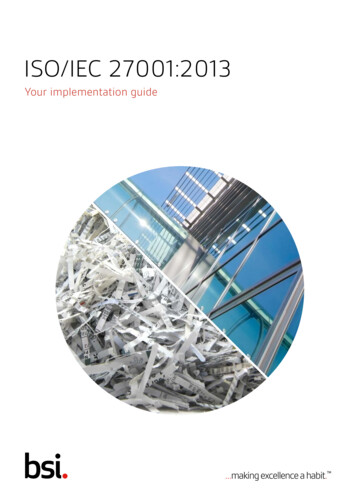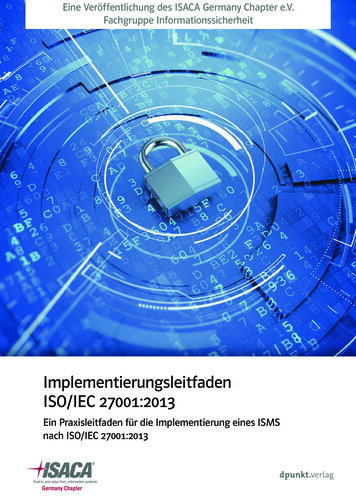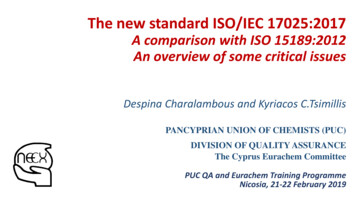
Transcription
The new standard ISO/IEC 17025:2017A comparison with ISO 15189:2012An overview of some critical issuesDespina Charalambous and Kyriacos C.TsimillisPANCYPRIAN UNION OF CHEMISTS (PUC)DIVISION OF QUALITY ASSURANCEThe Cyprus Eurachem CommitteePUC QA and Eurachem Training ProgrammeNicosia, 21-22 February 2019
The Standard is applicable to all laboratories, regardless of the number of personnel.There had been some discussion on this issue regardingimpartiality and independence. It is considered that sometasks e.g. internal audit have to be undertaken by hiringpart-time personnel21-22 February 2019Critical issues of the ISO/IEC 17025 and ISO 151892
What is changing in ISO/IEC 17025?from to 21-22 February 2019Critical issues of the ISO/IEC 17025 and ISO 151893
Despite the big differences at a glance In practice, these are not too many or difficult to beaddressed; however, what is changing refers mostly to thephilosophy of the document, thus affecting both thepreparation of the laboratory and the assessment by theaccreditation body21-22 February 2019Critical issues of the ISO/IEC 17025 and ISO 151894
Τhe new standard is written in a less prescriptive form it is a no tick box standard at all! More flexibility is given to laboratories how to address the variousissues/requirements Not every “shall” leads to a question which, in case of a “NO”answer leads to a nonconformity; assessors need to put morequestions This means that assessors need to be well trained to meet thechallenge! This also underlines the need for harmonisation.21-22 February 2019Critical issues of the ISO/IEC 17025 and ISO 151895
What is changing? The structure The terminology The introduction of new provisions Risk and opportunities The Management System Reference to new standards The Annexes21-22 February 2019Critical issues of the ISO/IEC 17025 and ISO 151896
The structure of the new standard is in line with other recent standards in 17000 series; there arefive sections:– General requirements– Structural requirements– Resource requirements– Process requirements– Management requirements21-22 February 2019Critical issues of the ISO/IEC 17025 and ISO 151897
Sections 4 and 5 of the Standard are now presented in more detail under four sectors. A seriesof notes have been included in the text of the Standard, thuswith substantially increased importance. Furthermore Two Annexes, both informative, are included:- Annex A - Metrological traceability- Annex B - Management system. Notes and Annexes do not provide the basis for raisingnonconformities21-22 February 2019Critical issues of the ISO/IEC 17025 and ISO 151898
From the recent Eurachem leaflet “A new ISO/IEC 17025 for laboratories”21-22 February 2019Critical issues of the ISO/IEC 17025 and ISO 151899
Comparison with the 2005 version The main changes compared to the previous edition are: The risk-based thinking applied in this edition has enabledreduction in prescriptive requirements and replacement byperformance-based requirements There is greater flexibility in the requirements for processes,procedures, documented information and organizationalresponsibilities A definition of "laboratory“ is added21-22 February 2019Critical issues of the ISO/IEC 17025 and ISO 1518910
Comparison with the 2005 version continues The main changes compared to the previous edition are: Most of the provisions under clause 5 now appear underclauses 6 and 7 Specific sub clauses of under the new clause 4 now provide forindependence and impartiality. They are more detailed thanthe equivalent clauses in the 2005 edition Externally provided products and services cover both servicesand supplies, and subcontracting21-22 February 2019Critical issues of the ISO/IEC 17025 and ISO 1518911
A laboratory performs one or more of the following activities: calibration testing sampling (associated with subsequent calibration or testing*)* Not necessarily carried out in the same entity – this means thatsampling as a stand-alone activity is accreditable against this Standard inline with EA Resolution 2015 (35) 20 The term “the laboratory” is used throughout the text without anydistinction, except in cases of different/additional requirements.21-22 February 2019Critical issues of the ISO/IEC 17025 and ISO 1518912
The Standard specifies the meaning of the following terms: “shall“ indicates a requirement “should“ indicates a recommendation “may“ indicates a permission “can“ indicates a possibility or a capability21-22 February 2019Critical issues of the ISO/IEC 17025 and ISO 1518913
Terms and definitionsA series of terms and definitions are added*: Impartiality (according to ISO/IEC 17021) Complaint (according to ISO/IEC 17000) Interlaboratory comparison (according to ISO/IEC 17043) Proficiency testing (according to ISO/IEC 17043) Intralaboratory comparison Laboratory Decision rule (how to account measurement uncertainty whenstating conformity with a specified requirement)*Definitions given in ISO/IEC 17000 and ISO/IEC Guide 99 (VIM)21-22 February 2019Critical issues of the ISO/IEC 17025 and ISO 1518914
Roles and names Laboratory management used instead of top management The term quality manager is not used.Relevant responsibilities are to be assigned to competentpersonnel21-22 February 2019Critical issues of the ISO/IEC 17025 and ISO 1518915
Important aspects Impartiality and confidentialitySampling as a stand-alone activityRisk management and opportunitiesSubcontractingThe use of a decision ruleTraceability from calibration certificatesEnsuring the validity of resultsControl of dataOpinions and interpretationsManagement optionsThe transition period21-22 February 2019Critical issues of the ISO/IEC 17025 and ISO 1518916
Other changes Additional provisions are now included under controlof data – Information management Improvement now includes feedback from the customer. No need to rewrite the methods! The laboratory has torefer to standard method provided there are nodeviations or adjustmentscontinued 21-22 February 2019Critical issues of the ISO/IEC 17025 and ISO 1518917
Other changes (2) The issue of liability is more elaborated;some of its aspects are addressed under confidentiality A new clause 4.1 will now refer only to impartiality.Relevant provisions are more detailed Externally provided products and services cover bothservices and supplies and subcontracting21-22 February 2019Critical issues of the ISO/IEC 17025 and ISO 1518918
Examples of notes of the Standard which have been transferred in the text of Standard: metrological traceability sampling validation of methods reference materials proficiency testing21-22 February 2019Critical issues of the ISO/IEC 17025 and ISO 1518919
Ιmpartiality and confidentiality The new standard makes no reference to independence!*Emphasis is given to impartiality (4.1), defined as “presence ofobjectivity” (3.1) and confidentiality (4.2). In Note 1 to entry, it is explained that “Objectivity means thatconflicts of interest do not exist, or are resolved so as not toadversely influence subsequent activities of the laboratory”.*As a result, all laboratories (1st, 2nd or 3rd party) can meet therequirements of the Standard, provided that impartiality isdemonstrated.21-22 February 2019Critical issues of the ISO/IEC 17025 and ISO 1518920
An accredited laboratory uses the accreditation logo on its reports only for results fromthe activities defined for compliance with the Standard.Appropriate indication of activities within or outside of theaccreditation scope needs to be ensured according to thedetailed policy of the national accreditation body.Note : this is not a new issue, but it is very important withregards to work not carried out in the laboratory, on apermanent basis21-22 February 2019Critical issues of the ISO/IEC 17025 and ISO 1518921
Metrological traceability* The laboratory shall establish and maintain metrologicaltraceability of its measurement results by means of adocumented unbroken chain of calibrations, each contributingto the measurement uncertainty, linking them to anappropriate reference (clause 6.5.1).* ISO/IEC Guide 99 The above guide indicates that a measurement result isgenerally expressed as a single measured quantity valueincluding a unit of measurement and a measurement uncertainty Annex A is informative 21-22 February 2019Critical issues of the ISO/IEC 17025 and ISO 1518922
According to Annex A Establishing metrological traceability needs: The specification of the measurand A documented unbroken chain of calibrations going back to stated andappropriate references Evaluation of measurement uncertainty according to agreed methods Each step to be performed in accordance with appropriate methods(measurement results with associated measurement uncertainties) Contributing laboratories supply evidence of their technical competencefor the respective steps (A.2)21-22 February 2019Critical issues of the ISO/IEC 17025 and ISO 1518923
The laboratory shall ensure that measurement results are traceable to SI units. How?6.5.2 provides for this a) calibration provided by a competent laboratory; those fulfilling the requirements of this standard are considered to becompetentb) certified values of certified reference materials by a competentproducer with stated metrological traceability to SI; producers fulfilling the requirements of ISO 17034 are consideredto be competentc) Direct or indirect realisation of the SI units by comparison with national orinternational standards see SI brochure 1-22 February 2019Critical issues of the ISO/IEC 17025 and ISO 1518924
Further to this, Annex A also refers to how metrological traceability can be established (A.3).In practice, it briefly reflects the provisions of ΙLAC P 10 withreference to international arrangements (CIPM MRA – ΚCDB) accreditation by bodies under ΙLAC ΜRA/regional MLA Joint BIPM, OIML, ILAC and ISO Declaration on MetrologicalTraceability C-ISO joint declaration 2011.pdf)21-22 February 2019Critical issues of the ISO/IEC 17025 and ISO 1518925
In case metrological traceability to SI units is not possible, the laboratory shall demonstrate metrologicaltraceability to an appropriate reference e.g.a) certified values of certified reference materials by a competentproducerb) results of reference measurements procedures, specifiedmethods or consensus standards(6.5.3)21-22 February 2019Critical issues of the ISO/IEC 17025 and ISO 1518926
Additional provisions A declaration by the laboratory for the range of its activitiesconforming with the Standard, excluding activities externallyprovided on an ongoing basis Consideration of activities at facilities outside thelaboratories permanent control Capability of the laboratory to- properly perform methods (verification-records)- develop new methods-qualified personnel-periodic reviewcontinued 21-22 February 2019Critical issues of the ISO/IEC 17025 and ISO 1518927
Additional provisions (2) When statement of conformity to a specification/standard isprovided, the laboratory shall document the decision ruleemployed taking into account the level of risk (false accept andfalse reject) – reference to ISO/IEC Guide 98-4 Opinions and interpretations are addressed in more detail; theneed for documentation of the basis (the results obtained) andthe competence of the personnel releasing them – Not to beconfused with inspections and product certifications (ISO 17020and ISO 17065).continued 21-22 February 2019Critical issues of the ISO/IEC 17025 and ISO 1518928
Additional provisions (3) The agenda for Management Review meetings is widened toreflect the various changes (include 6 new)– Changes in interval and external issues– Fulfilment of objectives– Status of actions from previous management reviews– Effectiveness of any implemented improvements– Adequacy of resources– Results of risk identification21-22 February 2019Critical issues of the ISO/IEC 17025 and ISO 1518929
Options for laboratoriesThe laboratory shall establish, document, implement andmaintain a management system that is capable of supportingand demonstrating the consistent achievement of therequirements of this document and assuring the quality ofthe laboratory results.In addition to meeting the requirements of Clauses 4 to 7,the laboratory shall implement a management system inaccordance of Option A (8.1.2) or Option B (8.1.3)21-22 February 2019Critical issues of the ISO/IEC 17025 and ISO 1518930
Options for laboratories (2)Option AClauses 4-7and 8.2-8.9OROption BISO 9001 (Clauses8.2-8.9) and clauses4-7 (technicalcompetence)Figure 2: Management system optionsA laboratory that has established and maintains a management system inaccordance to ISO9001 and that is capable of supporting and demonstrating theconsistent requirements of Clauses 4 to 7, also fulfils at least the intent of themanagement system requirements specified in 8.2 to 8.9From the recent Eurachem leaflet “A new ISO/IEC 17025 for laboratories”21-22 February 2019Critical issues of the ISO/IEC 17025 and ISO 1518931
The transition periodAccording to ILAC resolution GA 20.15, the transition period isset for three years after the publication of the new standard.The new standard was published on 30 November 2017.This means that by 30 November 2020 valid accreditationcertificates need to be granted on the basis of ISO/IEC17025:2017.After this date, no accreditation certificate to ISO/IEC17025:2005 will be recognized.21-22 February 2019Critical issues of the ISO/IEC 17025 and ISO 1518932
It is not an easy task to compare the two documents; some aspects are addressed in a differentway and in more than one paragraphs while some new aspectsare added.However, it does not mean that such changes including the “none
ILAC-ISO_joint_declaration_2011.pdf) 21 -22 February 2019 Critical issues of the ISO/IEC 17025 and ISO 15189 25 . In case metrological traceability to SI units is not possible, the laboratory shall demonstrate metrological traceability to an appropriate reference e.g. a) certified values of certified reference materials by a competent producer b) results of reference measurements procedures .
